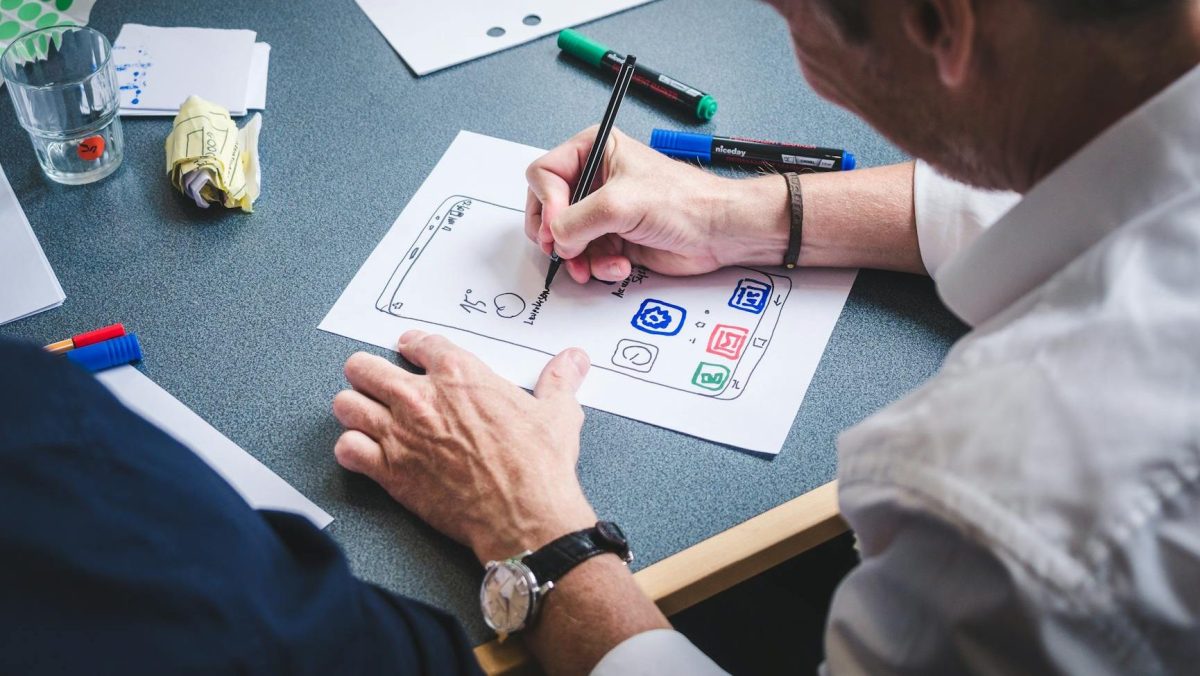His focus is on how people interact with a product, and his work encompasses the design of the complete user experience when interacting with digital interfaces, such as applications, websites or software.
That is, the final product must be functional to provide a positive, efficient and satisfying user experience, ensuring that the product is useful, easy to use based on rigorous research and an iterative process of testing and refinement.
UX Design Objectives
- Ease of use: that users can complete their tasks with minimal effort.
- Efficiency: users complete tasks quickly.
- Satisfaction: that users have a positive experience and feel good about using the product.
- Accessibility: that the product can be used by people with various abilities and disabilities.
- Engagement: keeping users interested and engaged with the product.
In contrast, User Interface (UI) Design is about creating visual and interactive elements of a product to achieve an engaging, intuitive and cohesive user experience. Once the final structure is decided and the prototype is approved, UI design begins.
UI design objectives
- Aesthetic appeal: visually appealing interfaces that reflect the brand identity.
- Usability: ensure that users can easily interact with the interface.
- Consistency: maintain a uniform design language throughout the product Accessibility: design interfaces that can be used by people with various abilities and disabilities.
- Engagement: make the interface attractive and pleasant to use to encourage users to interact with the product.
The scope
- UX: focuses on the broader experience of using the product (how it works and how it meets the user’s needs).
- UI: focuses on the surface aspects of a product (how it looks and feels).
The process
- UX: involves user research, profiling, wireframing, prototyping and testing.
- UI: involves creating visual designs, style guides and interactive elements.
Usability
Usability is a quality attribute of a product that simply refers to its ease of use. It is not a universal attribute, as a product will be usable if it is usable for its specific audience and for the specific purpose for which it was designed.
It refers to how we use things, how easily we use them, and whether they enable us to do what we need or want to do. It is an ease of use characteristic, essentially applied to software, but relevant to any human artefact.
In general terms, a product or application is easy to use when it effectively fulfils the task for which it is used.
Usability criteria
- Ease of learning. The system or product must be easy to learn.
- Efficiency of use. The productivity level of the user who has learned to use the product must be high in order to be able to complete certain tasks.
- Ease of memorisation. The system must be easy to remember.
- Errors. It should generate as few errors as possible.
- Satisfaction. It should provide comfort and a positive attitude during use.
Principles of usability
- Consistency. An interactive product must be graphically and interactively coherent to avoid confusion and complications. This consists of using the same buttons or interactive icons, the same colours, the same terminology and organisation on each of the screens.
- Interaction. Interaction must be predictable, visible and reversible. The goal must be that the user feels comfortable with the interface and can know that when they try an action, they will see the result and can undo it if they don’t like it.
- Information, communication and feedback. Help users find information quickly and easily, use text links, headings and provide simple and clear instructions.
- Control. People must be able to take the initiative to take numerous actions.
- Choice. Users must be offered more than one way to find what they are looking for so they can choose the most appropriate method of interaction for their situation.
Tasks of a UX designer
- User research: Research the needs, behaviours, motivations and expectations of users through interviews, surveys, data analysis and behavioural studies.
- Problem analysis and definition: Once the information has been obtained, the designer defines which specific user problems or needs must be solved with the product.
- Creation of personas and scenarios: Develops fictional representations of real users based on the research, in order to design for different types of audiences and situations.
- Structure design (information architecture): Organises and structures product information, ensuring that users can navigate the interface intuitively.
- Prototyping: Creates preliminary representations of the product, either in the form of sketches or low-fidelity interactive prototypes, to visualise the flow and structure of the interface.
- User testing: Conducts tests with real users to verify how they interact with the prototype and whether they experience difficulties. The results guide necessary improvements.
- Design Iteration: Based on feedback and testing, continually adjust and improve the design until it is aligned with user expectations and needs.
- Collaboration with development teams: Works closely with developers, UI designers, and other professionals to ensure that the implemented design is true to the original vision and functional for the end user.
How does he/she do this?
The designer uses design software such as Sketch, Figma, Adobe XD, or InVision to create prototypes and interactive designs, and uses techniques such as user-centred design (UCD), A/B testing, wireframes, and user flows.
It relies on collaboration with other designers and teams to validate ideas and ensure that the design is aligned with business goals and user needs.
A UX designer is dedicated to designing intuitive, effective and enjoyable digital experiences for users. Through a user-centric process, their role involves researching how people interact with digital products or services, with the goal of improving or creating interfaces that are easy to use and aligned with user needs.
Responsibilities of a UX designer
- User research: Research is one of the pillars of UX design. The designer must deeply understand who the users are, what they need, and how they interact with similar products. This phase includes:
- Interviews and surveys: Conversing with potential or current users to learn about their expectations, challenges, and behaviours.
- Data analysis: Reviewing previous usage metrics or behaviours on similar products to identify patterns.
- Customer Journey Maps: Identify each step a user takes when interacting with a product or service, from first contact to completion.
- Problem definition: After research, the UX designer clearly defines what problems or needs must be addressed. This involves synthesising the data collected to formulate hypotheses or problems to be solved. For example, you may discover that users are abandoning a registration process because it is too long or confusing.
- Creating archetypes or personas: Personas are fictional representations based on real user data. They describe the different types of users you are designing for, detailing their needs, behaviours, frustrations and goals. These archetypes help keep the design approach aligned with real users throughout the development process.
- Information architecture: This refers to how information is organised within the interface. The UX designer defines how content is grouped and presented, ensuring that the user can find what they are looking for with ease.
This involves:
- Site maps: Representing the hierarchical structure of a site or application.
- User flows: Visualising the steps users will take within the platform to complete a specific task.
- Wireframes and prototypes: Wireframes are basic sketches that show the skeleton of the interface, i.e. the layout of key elements (buttons, menus, etc.) without worrying about the visual design. More detailed prototypes are then created, which may include basic interaction to show how the different parts of the system will work. This step is crucial to visualise what the user experience will be like before the product is fully developed.
- User testing: A UX designer must validate their hypotheses and prototypes with real users. This is done through usability testing, where users interact with the product while the designer observes their behaviour and receives feedback. Some common techniques include:
- Usability testing: Observing how users complete specific tasks in the prototype.
- A/B testing: Comparing two versions of an interface to see which one works better.
- Iteration: UX design is an iterative process. This means that the designer must be willing to continually adjust and improve the design based on test results. If one part of the design does not meet the user’s expectations or has problems, that area is reworked.
- Interaction design: The UX designer is also responsible for designing how users interact with the product. This includes planning the transitions between screens, the interface’s response to user actions (such as clicks or scrolling), and ensuring that each action has clear feedback for the user.
- Collaboration with development teams: Once the design has been approved, the UX designer works closely with developers to ensure that the final product reflects the decisions made during the design process. This may involve clarifying interaction issues or helping to correctly implement certain features.
- Post-launch evaluation: After the product has been launched, the UX designer analyses its performance based on actual usage metrics and user feedback. If necessary, he continues to make adjustments or improvements in future versions of the product.
Tools used
- Figma, Sketch, Adobe XD: Tools to create wireframes and interactive prototypes.
- InVision, Axure: Software to develop prototypes and perform usability testing.
- Google Analytics, Hotjar: Platforms for analysing how users interact with a website or application.
- Miro, Trello, Jira: Project management tools for working collaboratively with development teams.
Essential skills
- Empathy: Understanding deeply the needs, emotions and motivations of users.
- Critical thinking and problem solving: Ability to analyse complex problems and propose creative solutions.
- Communication: Crucial to collaborate effectively with development teams, product managers and other areas.
- Technical knowledge: Although it is not necessary to know how to code, it is useful to have a basic understanding of how web and mobile technologies work in order to collaborate with developers.
How do you do it?
- Iterative design cycle: Through a cyclical process of design, testing and continuous adjustment.
- User-centred design: Making decisions based on user research and data.
- Cross-functional collaboration: Working with other teams to ensure that the product meets both business objectives and user expectations.
To conclude this introduction to the world of UX Design, UX Design focuses on the complete user experience when interacting with a product. It focuses on usability, accessibility, and how the product solves the user’s needs.







